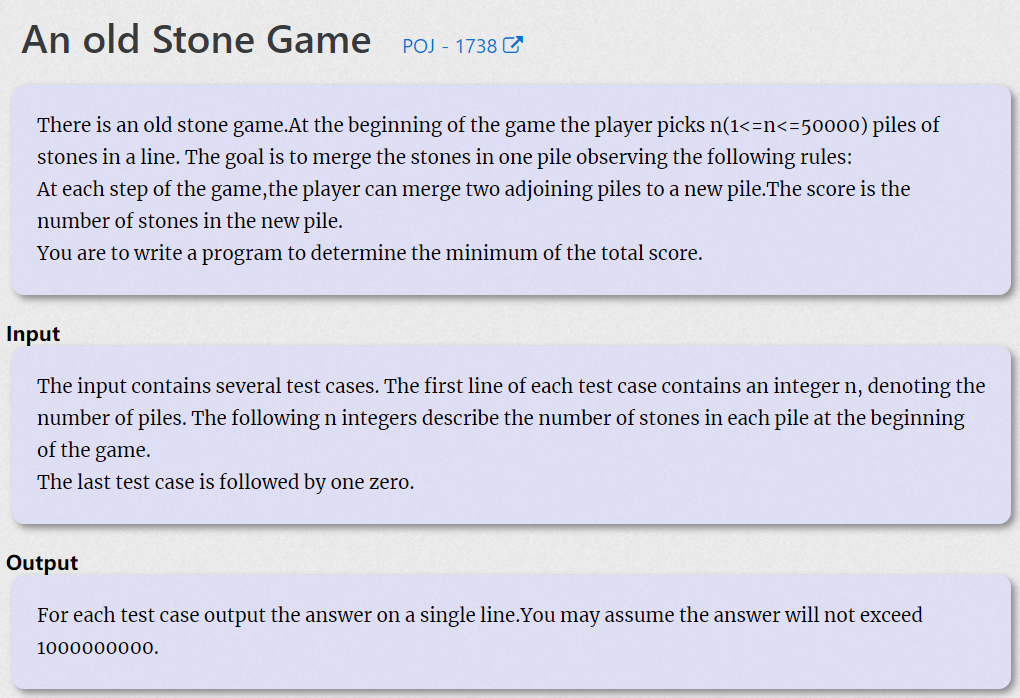

思路:
可以发现朴素的区间dp已经不足以解决这个问题了。对于石子合并问题,有一个最好的算法,那就是GarsiaWachs算法。时间复杂度为O(n^2)。
设序列是stone[maxn],从左往右,找到一个最小的且满足stone[k-1] <= stone[k+1]的k,找到后合并stone[k]和stone[k-1],再从当前位置开始向左找一个j满足stone[j] >= stone[k]+stone[k-1],然后把stone[k]+stone[k-1]插到j的后面就行。一直重复,直到只剩下一堆石子就可以了。
另外在这个过程中,可以假设stone[-1]和stone[n]是正无穷的,可省略边界的判别。把stone[0]设为inf, stone[n+1]设为inf-1,可实现剩余一堆石子时自动结束。
举个例子:
186 64 35 32 103
因为35<103,所以最小的k是3(下标从0开始),我们先把35和32删除,得到他们的和67,并向前寻找一个第一个大于等于67的数,把67插入到他后面,得到:186 67 64 103,现在由5个数变为4个数了,继续:186 131 103,之后得到234 186,k=2(别忘了,设A[-1]和A[n]等于正无穷大),最后得到420。最后的答案呢?就是各次合并的重量之和,即420+234+131+67=852。
基本思想是通过树的最优性得到一个节点间深度的约束,之后证明操作一次之后的解可以和原来的解一一对应,并保证节点移动之后他所在的深度不会改变。具体实现这个算法需要一点技巧,精髓在于不停快速寻找最小的k,即维护一个“2-递减序列”朴素的实现的时间复杂度是O(n*n),但可以用一个平衡树来优化,使得最终复杂度为O(nlogn)。
AC_Code
#include <cstdio> #include <cstring> #include <string> #include <cmath> #include <queue> #include <stack> #include <vector> #include <set> #include <map> #include <algorithm> using namespace std; typedef long long ll; const int maxn=50005; const ll mod=1e9+7; const int inf=0x3f3f3f3f; const double eps = 1e-9; int stone[maxn],n,ans,t; void combine(int k){ int tmp=stone[k-1]+stone[k]; ans+=tmp; --t; for(int i=k;i<t;i++) stone[i]=stone[i+1]; int j; for(j=k-1;stone[j-1]<tmp;--j){ stone[j]=stone[j-1]; } stone[j]=tmp; while( j>=2 && stone[j]>=stone[j-2] ){ int d=t-j; combine(j-1); j=t-d; } } int main() { while( ~scanf("%d",&n)&&n){ stone[0]=inf; stone[n+1]=inf-1; for(int i=1;i<=n;i++){ scanf("%d",&stone[i]); } ans=0; t=3; for(int i=3;i<=n+1;i++){ stone[t++]=stone[i]; while( stone[t-3]<=stone[t-1]){ combine(t-2); } } while( t>3 ) combine(t-1); printf("%d ",ans); } return 0; }